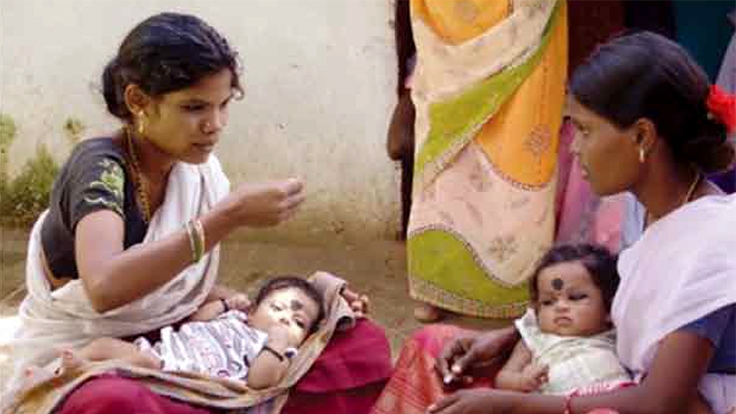Although India has seen strong economic growth over the past 20 years, childhood malnutrition rates have remained very high. The prevalence of malnutrition in children under five in India continues to be among the highest in the world – higher even than in Sub-Saharan Africa.
A pilot program carried out under the World Bank-supported Andhra Pradesh Rural Poverty Reduction Project has shown that community-managed Nutrition-Cum-Day Care Centers (NDCCs) can make a difference. Although it is too early to measure overall reductions in malnutrition levels, early indicators show that the NDCCs display promising potential to improve the nutritional status of pregnant and lactating women and their children in the long term.
A number of innovative aspects account for the pilot program’s success. Foremost among these is the fact that, unlike current programs that are administered in a topdown manner, the NDCCs are community driven, community-owned, and communitysupervised. They have been built on the strong social infrastructure of Andhra. Pradesh’s women’s self help groups (SHG), their village organizations, and federations that has been established across the state over the past 16 years. With local women functioning as leaders, mentors, and trainers, the program has been able to gain wide acceptance within communities and scale up across the state with ease.
Unlike current programs that provide supplementary nutrition in the form of dry rations for the women to take home, the NDCCs provide pregnant and lactating women and their children under 2 with three cooked, well-balanced meals a day, ensuring that the food is indeed consumed by the beneficiaries themselves and not diverted to other family members.
The pilot program’s other groundbreaking feature is that the centers get a one-time grant of Rs. 300,000 (US $ 6,000 approx.), unlike other grant programs where resources are required year after year. Moreover, the cost of the meals is recovered in full, making the program financially sustainable over the long term. A number of measures have been adopted to reduce the costs of the meals. This is done by tying up with various government programs such as the Integrated Child Development Scheme (ICDS) and the Public Distribution System (PDS) to obtain supplementary nutrition powders and staples such as rice/wheat, dal, and oil at subsidized prices; bulk purchasing dry rations such as pulses, oil etc. at lower prices through the women’s SHGs; and using fresh produce from the centers’ own community kitchen gardens. Profits from the other activities that are routinely undertaken by the SHGs, as well
as interest income from the one-time grant, are also used to finance the cost of the meals.
One third of the cost of the meals is recovered from the women themselves. As a part of the SHG network, the women are helped to come together in groups to undertake safe livelihood activities so that they do not have to engage in manual labor to earn a living during this vulnerable period. These activities enable the women to earn about Rs. 800 to Rs. 1,000 a month, making it possible for even the poorest of the poor to contribute towards the cost of their meals, as well as take home an income.
Since 2007, some 4,200 NDCCs have been established in villages across Andhra Pradesh, reaching some 220,800 women and young children so far. Many of the centers have been set up in areas which are home to predominantly disadvantaged communities, including tribal and fisherfolk groups. Some 1,100 centers are functioning in districts where left-wing extremists are active.
Similar pilots are also being implemented under World Bank-supported projects in Bihar, Chhattisgarh, Madhya Pradesh, Orissa and Tamil Nadu, and there are plans to replicate the model across the country under the National Rural Livelihood Mission.

